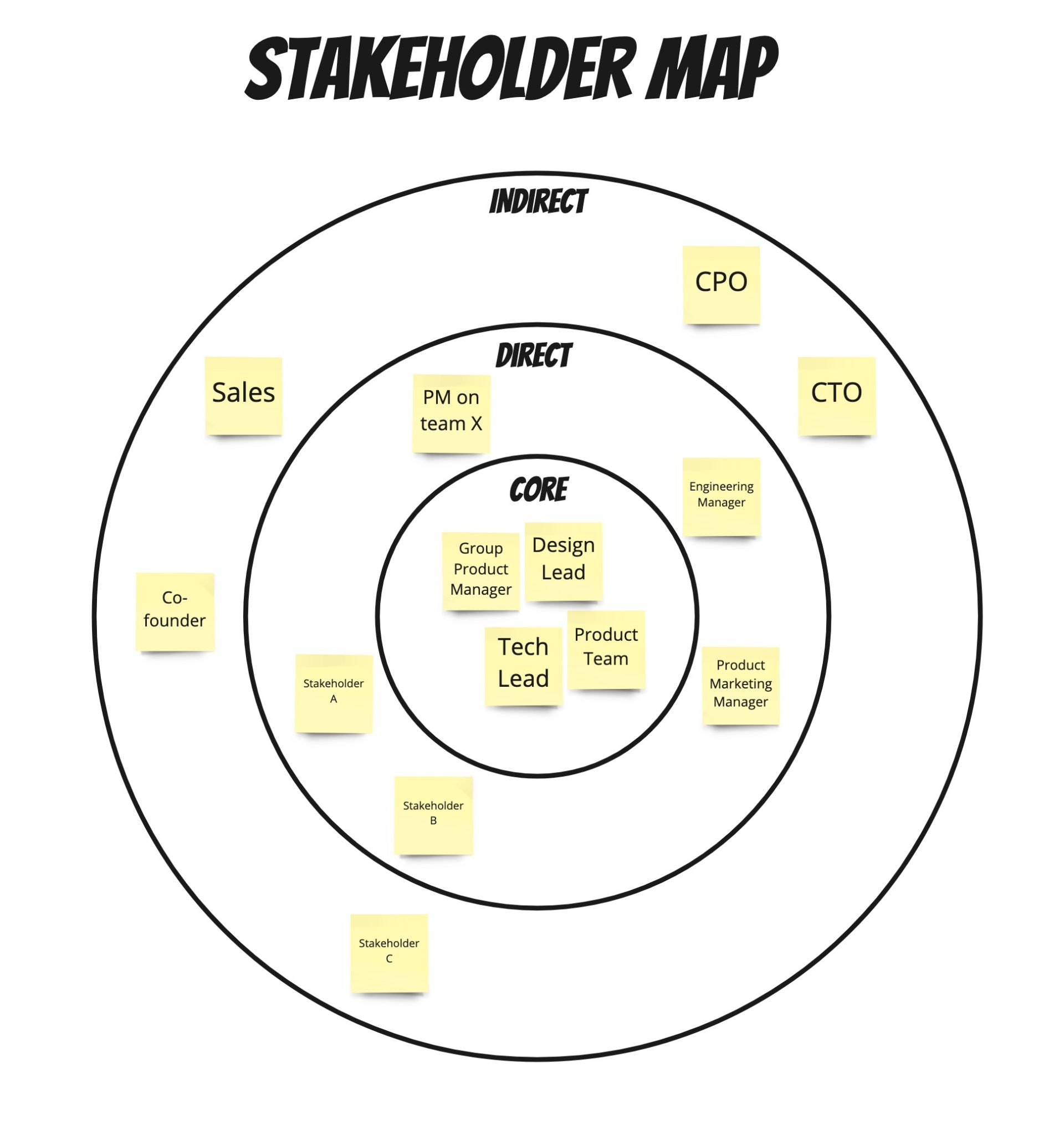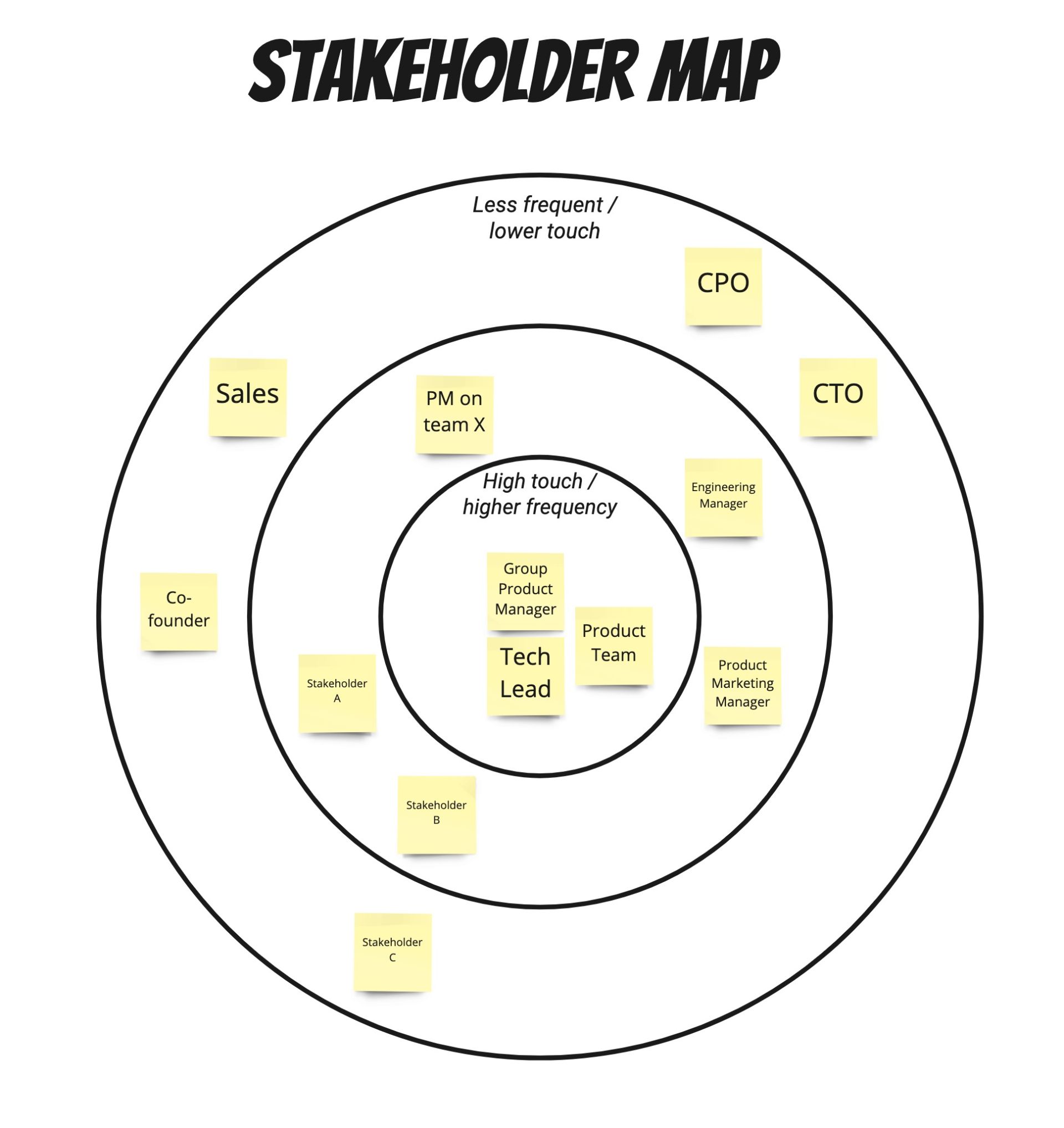Stakeholder Engagement Framework
Empty space, drag to resize
This is 1 of 3 frameworks for building a Stakeholder Engagement Strategy taught in the Stakeholder Management Essentials Course
Write your awesome label here.
How it works?
Using the following Stakeholder Map which categorises your Stakeholders by involvement into 3 categories:
CORE Stakeholders
DIRECT Stakeholders
INDIRECT Stakeholders

Depending on where each stakeholder falls on the Stakeholder Map will dictate how we engage with them.
Typically, stakeholders towards the centre (Core Stakeholders) are your key stakeholders and therefore should be engaged on a high frequency and via high touch methods.
Typically, stakeholders towards the centre (Core Stakeholders) are your key stakeholders and therefore should be engaged on a high frequency and via high touch methods.
Whilst those towards the outside (Indirect Stakeholders) have a lower involvement and concern and therefore you can get away with engaging with them in through light touch and infrequent methods.
As a results your engagement strategy looks like the following:
As a results your engagement strategy looks like the following:

Core Stakeholders
Core Stakeholders are stakeholders are your most important stakeholders. They have a high concern and involvement in your product and therefore require the most attention when building out an engagement strategy.
For Core Stakeholders you want to engage with them on a frequent basis. This typically means at least once a week to once every 2 weeks.
However, it's important to consider your context and how fast pace your organisation is. For example, if you're in a hyper-growth or very fast paced environment you may need to meet with your Core Stakeholders multiple times a week. I've experienced this before in high growth startups and when need to move quickly with short client engagements.
The opposite is also true. You may work in a slower pace company and once every 2 weeks might be too frequent. Once a month may be more appropriate given the pace of change in the organisation.
In addition to a high frequency. You want to engage with your Stakeholders in a 'high touch' manner. Meaning that we want to tailor the way we engage and communicate with them. This means adapting messaging or having bespoke meeting forums for these stakeholders.
Your main tool in regards to high touch engagement is the 1:1 meeting (there is an in-depth dive into running effective 1:1 meetings in the Stakeholder Management Essentials course).
Therefore typically you will find that for Core Stakeholders you will be having 1:1s with them at least once a week to once every two weeks.
For Core Stakeholders you want to engage with them on a frequent basis. This typically means at least once a week to once every 2 weeks.
However, it's important to consider your context and how fast pace your organisation is. For example, if you're in a hyper-growth or very fast paced environment you may need to meet with your Core Stakeholders multiple times a week. I've experienced this before in high growth startups and when need to move quickly with short client engagements.
The opposite is also true. You may work in a slower pace company and once every 2 weeks might be too frequent. Once a month may be more appropriate given the pace of change in the organisation.
In addition to a high frequency. You want to engage with your Stakeholders in a 'high touch' manner. Meaning that we want to tailor the way we engage and communicate with them. This means adapting messaging or having bespoke meeting forums for these stakeholders.
Your main tool in regards to high touch engagement is the 1:1 meeting (there is an in-depth dive into running effective 1:1 meetings in the Stakeholder Management Essentials course).
Therefore typically you will find that for Core Stakeholders you will be having 1:1s with them at least once a week to once every two weeks.
Direct Stakeholders
For Direct Stakeholders however, you will be engaging with them on a less frequent basis than your Core Stakeholders.You may also choose to engage with them through 'lower touch' means.
These two dimensions are your two lever points for either dial up or dial down the engagement method with your Stakeholders. In other words, you can increase or lower the frequency and/or increase or lower the way you engage with them.
It's typical to engage your Direct Stakeholders at least once a month or less frequently depending on your context. And in terms of 'touch', rather than engaging through 1:1s, you would be seeking to engage through stakeholder forums or showcases and sprint reviews. Meaning, rather than having a bespoke 1:1 meetings with the Direct Stakeholders (as you would with your Core Stakeholders) you would perhaps host a monthly stakeholder forum.
I typically like to categorise my Direct Stakeholders into common groups. For example, I may hold a monthly forum with all my customer facing stakeholders (e.g. sales, customer success and marketing). By creating stakeholders groups, such as putting all the delivery stakeholders, business or customer facing stakeholders, you are still tailoring your engagement to an extent but not as much as having individual 1:1s with each stakeholders. This is a typical middle-ground in terms of touch between high touch (e.g. 1:1s) and low touch (e.g. company wide communications).
These two dimensions are your two lever points for either dial up or dial down the engagement method with your Stakeholders. In other words, you can increase or lower the frequency and/or increase or lower the way you engage with them.
It's typical to engage your Direct Stakeholders at least once a month or less frequently depending on your context. And in terms of 'touch', rather than engaging through 1:1s, you would be seeking to engage through stakeholder forums or showcases and sprint reviews. Meaning, rather than having a bespoke 1:1 meetings with the Direct Stakeholders (as you would with your Core Stakeholders) you would perhaps host a monthly stakeholder forum.
I typically like to categorise my Direct Stakeholders into common groups. For example, I may hold a monthly forum with all my customer facing stakeholders (e.g. sales, customer success and marketing). By creating stakeholders groups, such as putting all the delivery stakeholders, business or customer facing stakeholders, you are still tailoring your engagement to an extent but not as much as having individual 1:1s with each stakeholders. This is a typical middle-ground in terms of touch between high touch (e.g. 1:1s) and low touch (e.g. company wide communications).
Indirect Stakeholders
Lastly we have your Indirect Stakeholders. These stakeholders have the lowest involvement in your product/area and as a result you can typically get away with simply keeping them informed.
Since there is a low return on investment with engaging with your Indirect Stakeholders any engagement should ideally be done in a low touch way and at a low frequency.
For example, you may only need to engage with your indirect stakeholders once a quarter or less frequently depending on your context.
Examples of 'low touch' engagement methods would be showcases, weeknotes, newsletter or update style emails.
It's therefore typically to only engage with your indirect stakeholders through broad communications such as Product Newsletters or company wide showcases.
Since there is a low return on investment with engaging with your Indirect Stakeholders any engagement should ideally be done in a low touch way and at a low frequency.
For example, you may only need to engage with your indirect stakeholders once a quarter or less frequently depending on your context.
Examples of 'low touch' engagement methods would be showcases, weeknotes, newsletter or update style emails.
It's therefore typically to only engage with your indirect stakeholders through broad communications such as Product Newsletters or company wide showcases.
Mapping out your Stakeholder Engagement Strategy
Using your stakeholder map and the above as a guide, walk through your stakeholders and write down, how you intent to engage with them? And at what frequency?
Remember that those towards the centre (core stakeholders) will require a higher frequency and high touch method. And those towards to edges (Indirect Stakeholders) you can get away with a low frequency and low touch methods.
Remember that those towards the centre (core stakeholders) will require a higher frequency and high touch method. And those towards to edges (Indirect Stakeholders) you can get away with a low frequency and low touch methods.
Conclusion
Whether we like it or not, not all stakeholders are created equal, and some will need higher touch and more frequent engagement and others less. It can be dangerous to treat all stakeholders equally.
It's also important that we don't find ourselves time poor because we've taken a blanked approach to stakeholder engagement and have scheduled dozens of 1:1s or necessary stakeholder forums.
It's also important that we don't find ourselves time poor because we've taken a blanked approach to stakeholder engagement and have scheduled dozens of 1:1s or necessary stakeholder forums.


